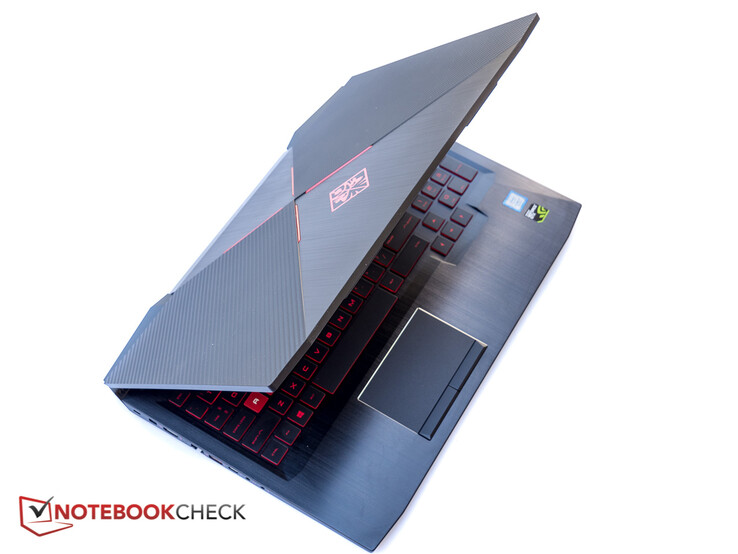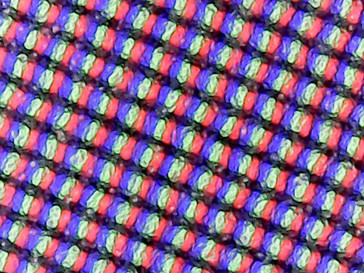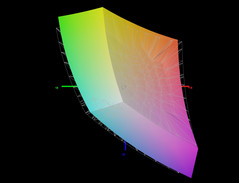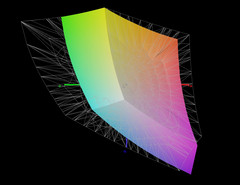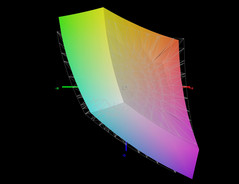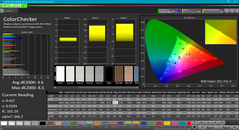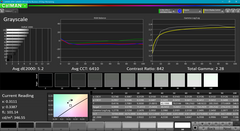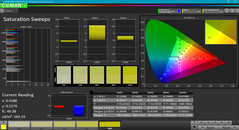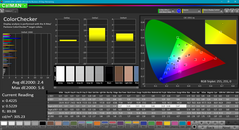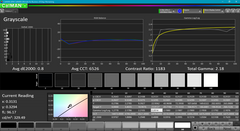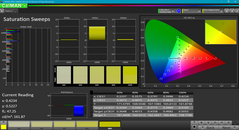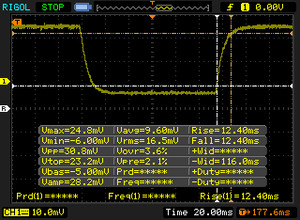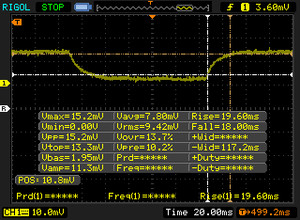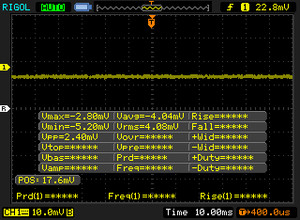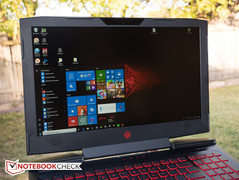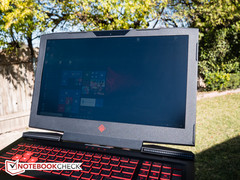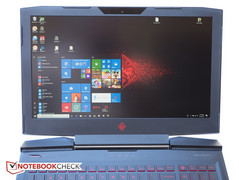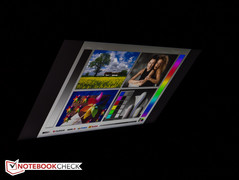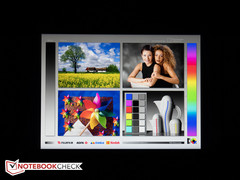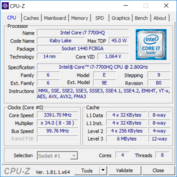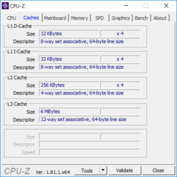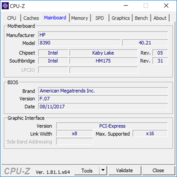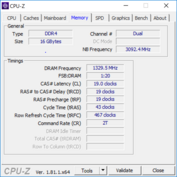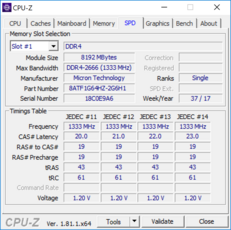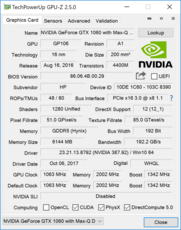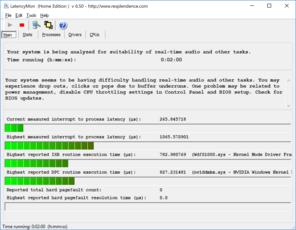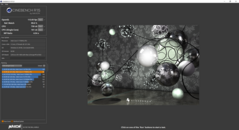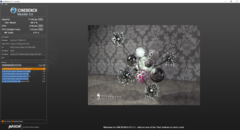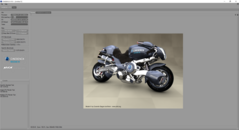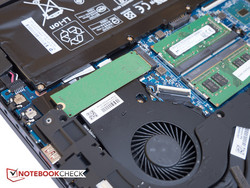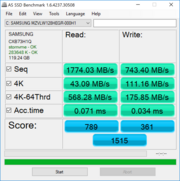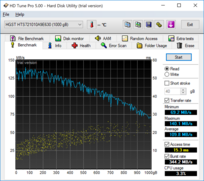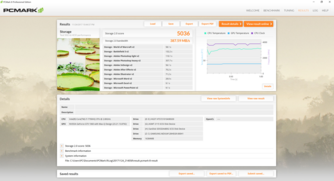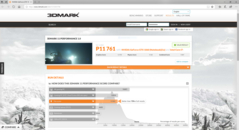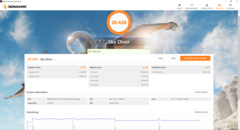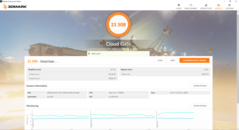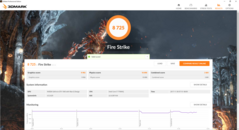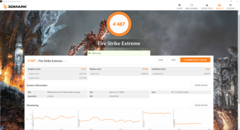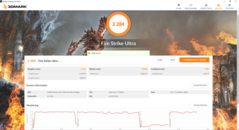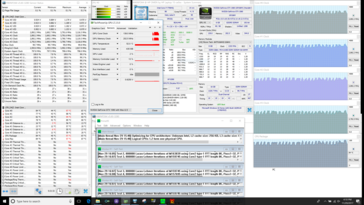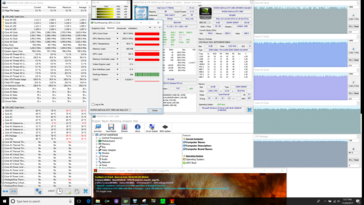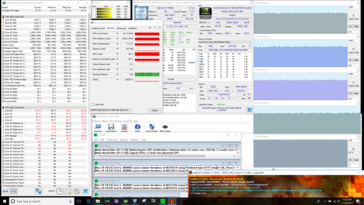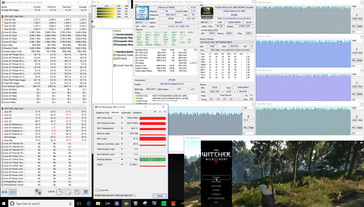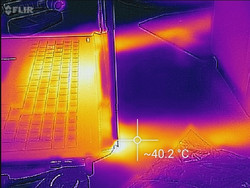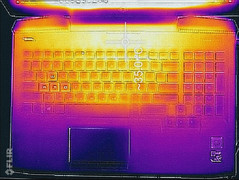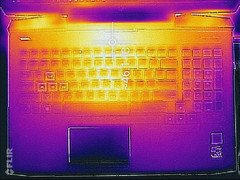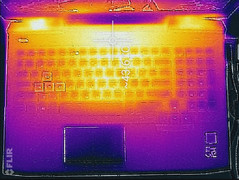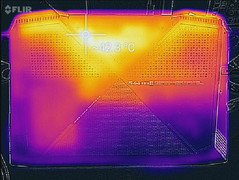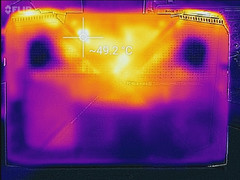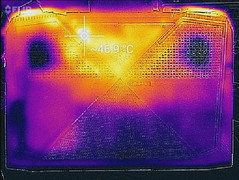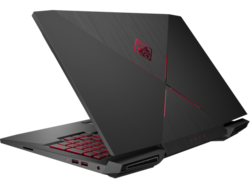HP Omen 15t-ce000 (7700HQ, GTX 1060 Max-Q, UHD) Laptop Review
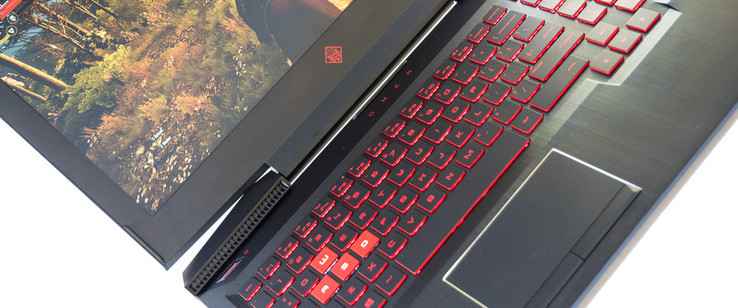
Our review of HP's overhauled and updated 15.6-inch Omen 15 with Intel Core i7-7700HQ and Nvidia GeForce GTX 1060 Max-Q a few months back left us with a positive impression overall: the mainstream gaming system features a new and a - for the most part - quite appealing design, a great display, and good performance. Negative aspects as noted by our editor are the very short battery life and the not inconsiderable amounts of heat and noise the notebook generates - at least considering this is a Max-Q design, which aims to keep the GPU operating within the optimum performance and power band to reduce both heat and noise. The notebook on our test bench this time comes equipped with the same CPU and GPU, but instead of the 120 Hz Full HD IPS panel, the Omen 15t-ce000 uses an upscale UHD/4K IPS display, once again featuring Nvidia's G-Sync technology. Our supplier CUKUSA sells our particular model (1WC88AV) with 128 GB SSD, 1 TB HDD, and 16 GB of RAM for a fairly reasonable price of $1350. HP offers the lowest-end Omen with Full HD display, AMD Radeon RX 550 and platter-based 1 TBdrive for $730, but curiously enough, there is no GTX 1060 option in the online store at the time of writing. A version of the notebook with GTX 1050Ti, 512 GB SSD and 1 TB HHD and 4K display costs $1200.
Since our previous Omen and our current unit are identical in most aspects, we'll skip certain sections, consolidate others and focus on the functional aspects as well as possible differences in performance, temperature, noise level and battery life.
The entry-to-mid-level gaming market is hotly contested and thus quite crowded, as most manufacturers offer at least one, if not several notebooks with dedicated GPUs in their lineup. Competitors are not hard to find and range from slightly less powerful GTX 1050Ti systems like the Lenovo Legion Y520 15IKBN to other GTX 1060 notebooks like the Gigabyte Aero 15 or the Acer Aspire V15 Nitro. We'll also compare the review notebook to the much less expensive $900 Dell Inspiron 15 7000 7577, which also uses the GTX 1060 Max-Q, but is equipped with a slower Core i5 CPU.
From a footprint and size perspective, most gaming notebooks in this class - with the notable exception of the Dell Alienware 15 R3 - are fairly comparable,. The Omen 15 isn't particularly slim at 25 mm - the much more expensive Gigabyte Aero 15 measures just 19 mm - but nonetheless leaps and bounds ahead of older gaming rigs. Most users aren't likely to quibble much about the weight, either, as the Omen is about average here at 2.6 kg. The aforementioned higher-end Alienware 15 R3 - known for its stout build quality but also for its considerable heft - weighs an astounding 1 kg / 38 % more.
Connectivity
The Omen 15 should satisfy most users when comes to its selection of physical ports. In addition to multiple video-outs, the notebook features 3x USB 3.0 Type A, 1x USB 3.1 Type C, and one Thunderbolt 3 connector.
SD Card Reader
The SD card reader shows very modest transfer rates compared to the Dell XPS 15 9560, although performance is still on par with other, entry-level gaming systems. Both the Dell Inspiron 15 7000 7577 and the Acer Aspire V15 feature SD card readers that are likely connected using a USB 2.0 interface and are therefore even slower. AS SSD attests transfer rates of 87.5 MB/s; a copy of one GB of jpeg files (about 5 MB each) from our Toshiba Exceria Pro SDXC 64 GB UHS-II reference card to the desktop takes about 14 minutes.
| SD Card Reader | |
| average JPG Copy Test (av. of 3 runs) | |
| Dell XPS 15 9560 (i7-7700HQ, UHD) | |
| Gigabyte Aero 15 | |
| HP Omen 15t-ce000 | |
| Dell Inspiron 15 7000 7577 | |
| Acer Aspire VN7-593G-73HP V15 Nitro BE | |
| maximum AS SSD Seq Read Test (1GB) | |
| Dell XPS 15 9560 (i7-7700HQ, UHD) | |
| Gigabyte Aero 15 | |
| HP Omen 15t-ce000 | |
| Dell Inspiron 15 7000 7577 | |
| Acer Aspire VN7-593G-73HP V15 Nitro BE | |
Communication
Unlike our previous review notebook, which featured an Intel Dual Band 7265 wireless card, our 4K Omen 15 is equipped with a Realtek RTL8822BE 802.11 ac WLAN module with a theoretical maximum throughput of 866 Mbit/s. Bluetooth 4.2 is included as well. Both transmit and receive speeds - established one meter away from our Linksys EA8500 reference router - are very good at 633 and 546 Mbit/s, respectively. With about half the throughput, the Lenovo Legion Y520 is by far the slowest notebook in our comparison.
Maintenance
Maintenance is a pretty simple affair: after a total of 10 Phillips screws have been removed, the bottom plate can be pried off with the aid of a plastic tool or old credit card. With the panel removed, the user then has access to the two RAM slots (both occupied in our case), the M.2 SSD, the 2.5-inch HDD, the WLAN-module as well as the two system fans should a cleaning become necessary. Since its access panel is secured by a single screw, the Dell Inspiron 15 7000 7577 is arguably even easier to maintain then our review notebook, although most users aren't necessarily going to open up their notebook all that frequently.
Warranty
In the US the Omen 15 is protected against manufacturers defects with a 1-year limited hardware warranty. HP of course offers various upgrades and extensions. At the time of writing, a 3-year warranty with accidental care protection sells for a very reasonable $190. Please see our Guarantees, Return Policies and Warranties FAQ for country-specific information.
Display
The Omen 15 reviewed by our German colleagues was equipped with the 15.6-inch IPS UWVA anti-glare Full HD display. Our review notebook features a 4K UHD anti-glare panel from AU Optronics (AUO23EB) with a resolution of 3840 x 2160 pixels. When selected during checkout, the panel upgrade only costs $90 - a true bargain, since many other manufacturers charge up to $300 for their higher-end panels.
At an average brightness of 350 cd/m², the 4K Omen 15 has a significantly brighter panel than the direct competitors with HD displays, which oftentimes top out at less than 300 cd/m². The inexpensive Inspiron 15 gaming notebook only reaches 225 cd/m². Contrast is acceptable as well at about 920:1 and thanks to the pixel density of 282 ppi, the panel is supremely sharp and - despite the anti-glare coating - not very grainy either. Note that the Aorus X5 v7 seems to use the same panel and thus offers similar quality and colors, but its recorded brightness was much lower.
The brightness distribution is impressive as well at 95 percent, but unfortunately, our panel suffers from noticeable backlight bleeding. When gaming or watching a movie, the clouding particularly in the bottom right corner can be distracting when truly dark backgrounds are displayed. At this point, we can't tell if this problem affects all units or just our review laptop. HP doesn't use PWM to control the brightness.
| |||||||||||||||||||||||||
Brightness Distribution: 95 %
Center on Battery: 358.5 cd/m²
Contrast: 919:1 (Black: 0.39 cd/m²)
ΔE ColorChecker Calman: 4.6 | ∀{0.5-29.43 Ø4.78}
ΔE Greyscale Calman: 5.2 | ∀{0.09-98 Ø5}
91.8% sRGB (Argyll 1.6.3 3D)
66.9% AdobeRGB 1998 (Argyll 1.6.3 3D)
66.9% AdobeRGB 1998 (Argyll 3D)
91.8% sRGB (Argyll 3D)
66.1% Display P3 (Argyll 3D)
Gamma: 2.28
CCT: 6410 K
| HP Omen 15t-ce000 AU Optronics AUO23EB, IPS, 15.6", 3840x2160 | Lenovo Legion Y520-15IKBN 80WK0042GE LG Philips LP156WF6-SPK3, IPS, 15.6", 1920x1080 | Dell Inspiron 15 7000 7577 ID: LG Philips LGD053F, Name: 156WF6, Dell P/N: 4XK13, IPS, 15.6", 1920x1080 | Gigabyte Aero 15 N156HCA-EA1 (CMN15D7), IPS, 15.6", 1920x1080 | Acer Aspire VN7-593G-73HP V15 Nitro BE LG Display LP156WF6-SPP1, AH-IPS, Normally Black, Transmissive, 15.6", 1920x1080 | HP Omen 15-ce002ng AUO42ED, IPS, 15.6", 1920x1080 | Aorus X5 v7 AU Optronics B156ZAN02.3 (AUO23EB), IPS, 15.6", 3840x2160 | |
|---|---|---|---|---|---|---|---|
| Display | -39% | -42% | -0% | -5% | -1% | -1% | |
| Display P3 Coverage (%) | 66.1 | 39.01 -41% | 37.07 -44% | 65.2 -1% | 65.8 0% | 65.8 0% | 65.3 -1% |
| sRGB Coverage (%) | 91.8 | 58.4 -36% | 55.6 -39% | 92.5 1% | 85.1 -7% | 90.9 -1% | 91.9 0% |
| AdobeRGB 1998 Coverage (%) | 66.9 | 40.34 -40% | 38.32 -43% | 66.5 -1% | 62.2 -7% | 66.5 -1% | 66.3 -1% |
| Response Times | -11% | -3% | -22% | -23% | -21% | -12% | |
| Response Time Grey 50% / Grey 80% * (ms) | 37.6 ? | 39 ? -4% | 35.6 ? 5% | 42.8 ? -14% | 41 ? -9% | 43.2 ? -15% | 44 ? -17% |
| Response Time Black / White * (ms) | 24.8 ? | 29 ? -17% | 27.6 ? -11% | 32 ? -29% | 34 ? -37% | 31.2 ? -26% | 26.4 ? -6% |
| PWM Frequency (Hz) | 21000 ? | 26000 ? | |||||
| Screen | -22% | -27% | -6% | -3% | 9% | 0% | |
| Brightness middle (cd/m²) | 358.5 | 283 -21% | 235.4 -34% | 320 -11% | 322 -10% | 304 -15% | 307 -14% |
| Brightness (cd/m²) | 350 | 281 -20% | 223 -36% | 316 -10% | 297 -15% | 289 -17% | 297 -15% |
| Brightness Distribution (%) | 95 | 91 -4% | 91 -4% | 90 -5% | 86 -9% | 86 -9% | 92 -3% |
| Black Level * (cd/m²) | 0.39 | 0.39 -0% | 0.28 28% | 0.36 8% | 0.31 21% | 0.26 33% | 0.3 23% |
| Contrast (:1) | 919 | 726 -21% | 841 -8% | 889 -3% | 1039 13% | 1169 27% | 1023 11% |
| Colorchecker dE 2000 * | 4.6 | 6.1 -33% | 5.6 -22% | 4.62 -0% | 4.73 -3% | 3.46 25% | 4.72 -3% |
| Colorchecker dE 2000 max. * | 8.5 | 11.08 -30% | 20.3 -139% | 9.75 -15% | 12.37 -46% | 7.72 9% | 8.07 5% |
| Greyscale dE 2000 * | 5.2 | 5.69 -9% | 3.6 31% | 6 -15% | 2.99 42% | 2.46 53% | 4.79 8% |
| Gamma | 2.28 96% | 2.44 90% | 2.23 99% | 2.46 89% | 2.32 95% | 2.38 92% | 2.42 91% |
| CCT | 6410 101% | 6702 97% | 7214 90% | 6761 96% | 6905 94% | 6915 94% | 7690 85% |
| Color Space (Percent of AdobeRGB 1998) (%) | 66.9 | 37 -45% | 35.2 -47% | 60 -10% | 56 -16% | 59 -12% | 60 -10% |
| Color Space (Percent of sRGB) (%) | 91.8 | 58 -37% | 55.4 -40% | 92 0% | 85 -7% | 91 -1% | 92 0% |
| Total Average (Program / Settings) | -24% /
-24% | -24% /
-27% | -9% /
-7% | -10% /
-6% | -4% /
3% | -4% /
-2% |
* ... smaller is better
At 92 and 67 percent of the sRGB and AdobeRGB standards, color space coverage is also quite competitive with only the very few notebooks offering a similar gamut. The Lenovo Legion Y520 15IKBN and the Dell Inspiron 15 7000 7577 are equipped with far inferior panels and cover sRGB to less than 60 percent, which makes them much less suitable for photo or video work than our review laptop. Of course, color space coverage will likely not be a determining factor for most when considering gaming system, but it's nice to know that at least occasional photo editing is not out of the question.
Further measurements with the X-Rite spectrophotometer show pretty accurate grayscale and color as shipped with DeltaE-deviations of 5.2 and 4.6, respectively. Color accuracy remains largely unaffected across all saturation levels. A quick calibration improves the results noticeably with the average color DeltaE dropping to 2.4 - blue remains largely unchanged at 5.6, however - while the grayscale DeltaE drops to a record-setting 0.8.
Note that while our previous review notebook featured a Full HD 120 Hz G-Sync panel, the 4K version is only 60 Hz. Interestingly enough, the response times of the 60 Hz UHD display - 24.8 (black-to-white) and 37.6 ms (gray-to-gray) - are actually slightly better than those of the Full HD 120 Hz version at 31.2 ms (black-to-white) and 43.2 ms (gray-to-gray), respectively.
Display Response Times
| ↔ Response Time Black to White | ||
|---|---|---|
| 24.8 ms ... rise ↗ and fall ↘ combined | ↗ 12.4 ms rise | |
| ↘ 12.4 ms fall | ||
| The screen shows good response rates in our tests, but may be too slow for competitive gamers. In comparison, all tested devices range from 0.1 (minimum) to 240 (maximum) ms. » 57 % of all devices are better. This means that the measured response time is worse than the average of all tested devices (20.2 ms). | ||
| ↔ Response Time 50% Grey to 80% Grey | ||
| 37.6 ms ... rise ↗ and fall ↘ combined | ↗ 19.6 ms rise | |
| ↘ 18 ms fall | ||
| The screen shows slow response rates in our tests and will be unsatisfactory for gamers. In comparison, all tested devices range from 0.165 (minimum) to 636 (maximum) ms. » 53 % of all devices are better. This means that the measured response time is worse than the average of all tested devices (31.6 ms). | ||
Screen Flickering / PWM (Pulse-Width Modulation)
| Screen flickering / PWM not detected | |||
In comparison: 53 % of all tested devices do not use PWM to dim the display. If PWM was detected, an average of 8108 (minimum: 5 - maximum: 343500) Hz was measured. | |||
Outdoor visibility is very acceptable both in the shade as well as under an overcast sky. The anti-glare coating and sufficient brightness of 350 nits makes this gaming rig far better suitable for outdoor use than many higher-end multimedia and mainstream notebooks. Working in the sunlight isn't really possible, but the matte panel makes deciphering the screen content nonetheless much easier compared to glossy touch panels. Viewing angle stability is good as expected with acceptable levels of darkening and no major color shifts.
Performance
Like the Omen 15 we reviewed earlier this year, our notebook is equipped with the same quad-core i7-7700HQ CPU, which can be found in many medium to high-end gaming notebooks. While other manufacturer usually offer the i5-7300HQ as well to lower the price of admissions, HP's new Omen 15 series doesn't offer any other Intel choices. RAM options range from 8 GB (single-channel) to 16 GB (dual-channel) on HP's site; users purchasing from CUKUSA can upgrade from 16 GB to 32 GB for $145 more. Depending on the SKU, users can get the Omen 15 with AMD Radeon RX 550 (2 GB dedicated) up to the GTX 1050 Ti (4 GB GDDR5 dedicated) directly from HP or with with GTX 1060 Max-Q (6 GB GDDR5 dedicated) from CUKUSA.
The Omen 15 uses G-Sync, so naturally, Nvidia Optimus is not supported.
Processor
The quad-core Intel Core i7-7700HQ features a TDP of 45 W and base clock of 2.8 GHz with Turbo boost up to 3.8 GHz. The result of 730 points for Cinebench R15 Multi is right were expected it to be with the high-end processor outperforming the lower-end Core i5-7300HQ in the Dell Inspiron 15 7000 7577 by about 30 percent. Note that the single-core performance of newer-generation CPUs like the 15 W Intel Core i7-8550U in the HP Spectre x360 15t-bl100 only trails the i7-7700HQ by very small margins, although sustained multi-core performance isn't nearly as good.
Compared to other notebooks with the same CPU, our Omen 15 doesn't handle the Cinebench R15 loop test (50 iterations) quite as well: after an initial high score of 736 points, subsequent scores drop by roughly 3 - 4 %. This minor reduction should be no reason for concern, nor is it even noticeable during normal use. As we will see later, this slight decline is caused by a drop in core frequency during prolonged CPU stress.
For more information about the Intel Core i7-7700HQ and additional benchmarks, please visit our dedicated processor page.
| Cinebench R10 | |
| Rendering Multiple CPUs 32Bit | |
| HP Omen 15-ce002ng | |
| HP Omen 15t-ce000 | |
| Lenovo Legion Y520-15IKBN 80WK0042GE | |
| Dell Inspiron 15 7000 7577 | |
| HP Spectre x360 15t-bl100 | |
| Rendering Single 32Bit | |
| HP Spectre x360 15t-bl100 | |
| HP Omen 15-ce002ng | |
| HP Omen 15t-ce000 | |
| Lenovo Legion Y520-15IKBN 80WK0042GE | |
| Dell Inspiron 15 7000 7577 | |
| wPrime 2.10 - 1024m | |
| HP Spectre x360 15t-bl100 | |
| Dell Inspiron 15 7000 7577 | |
| HP Omen 15t-ce000 | |
* ... smaller is better
System Performance
Perceived system performance is snappy with fast boot and response times. PCMark 8 scores have the Omen 15 at or near the top for both the Creative and Home scores, but the Work score ended up more than 50 percent below expectations even after several repeats. At this point we suspect the 4K panel, since our other Omen with the FHD panel did just fine here. The Digital Content Creation subtest of the PCMark 10 - composed of tasks like photo and video editing with with filters, downscaling, rendering and sharpening - is similarly affected by consistently low scores, although the difference isn't quite a pronounced. Notebooks like the Dell Inspiron 15 7000 7577 trail the review system by 15 - 30 %, since processor performance is important when running synthetic benchmarks and the i5-7300HQ doesn't quite perform as well as its more potent sibling.
At no time during our review did we experience any issues with the drivers or other software glitches.
| PCMark 8 | |
| Home Score Accelerated v2 | |
| HP Omen 15-ce002ng | |
| Aorus X5 v7 | |
| HP Omen 15t-ce000 | |
| Gigabyte Aero 15 | |
| Dell Inspiron 15 7000 7577 | |
| Lenovo Legion Y520-15IKBN 80WK0042GE | |
| Work Score Accelerated v2 | |
| HP Omen 15-ce002ng | |
| Gigabyte Aero 15 | |
| Dell Inspiron 15 7000 7577 | |
| Lenovo Legion Y520-15IKBN 80WK0042GE | |
| HP Omen 15t-ce000 | |
| Creative Score Accelerated v2 | |
| HP Omen 15t-ce000 | |
| Dell Inspiron 15 7000 7577 | |
| Lenovo Legion Y520-15IKBN 80WK0042GE | |
| PCMark 8 Home Score Accelerated v2 | 4325 points | |
| PCMark 8 Creative Score Accelerated v2 | 6901 points | |
| PCMark 8 Work Score Accelerated v2 | 2484 points | |
| PCMark 10 Score | 3969 points | |
Help | ||
Storage Devices
Just like our previous Omen 15-ce002ng, the current review notebook offers both a speedy SSD for the OS as well as a more economical HDD for storage. While the former was equipped with a 256 GB Samsung PM961 PCIe NVMe M.2 drive, our 4K model comes with the 128 GB version of the same drive. Speeds trail the larger 256 GB unit, particularly when it comes to sequential writes, although the drive is still very fast and thus never a bottle neck during regular operations. The secondary 2.5-inch 1 TB HGST Travelstar HDD spins at 7200 rpm and offers quite decent transfer rates of 110 MB/s according to HD Tune. 128 GB of primary storage is not a lot of space these days even if games and applications should be installed on the secondary platter-based HDD, so users wanting to make sure they have adequate space for at least a couple years can upgrade to the 256 GB PCIe NVMe SSD for $45 or to a 512 GB SSD for $130 when purchasing their unit from CUKUSA.
| HP Omen 15t-ce000 Samsung PM961 NVMe MZVLW128HEGR | Lenovo Legion Y520-15IKBN 80WK0042GE Samsung PM961 NVMe MZVLW128HEGR | Dell Inspiron 15 7000 7577 Samsung PM961 MZVLW256HEHP | Aorus X5 v7 Toshiba NVMe THNSN5256GPU7 | HP Spectre x360 15t-bl100 Samsung PM961 NVMe MZVLW512HMJP | |
|---|---|---|---|---|---|
| AS SSD | -9% | 32% | -436% | 133% | |
| Copy Game MB/s (MB/s) | 736 | 197.3 -73% | 382.5 -48% | 988 34% | 1134 54% |
| Copy Program MB/s (MB/s) | 195.4 | 127.3 -35% | 274.8 41% | 424.4 117% | 534 173% |
| Copy ISO MB/s (MB/s) | 1087 | 497.6 -54% | 814 -25% | 1482 36% | 1936 78% |
| Score Total (Points) | 1515 | 1434 -5% | 2405 59% | 490 -68% | 3781 150% |
| Score Write (Points) | 361 | 368 2% | 594 65% | 24 -93% | 1556 331% |
| Score Read (Points) | 789 | 746 -5% | 1241 57% | 361 -54% | 1493 89% |
| Access Time Write * (ms) | 0.034 | 0.032 6% | 0.037 -9% | 1.987 -5744% | 0.026 24% |
| Access Time Read * (ms) | 0.071 | 0.07 1% | 0.058 18% | 0.067 6% | 0.04 44% |
| 4K-64 Write (MB/s) | 175.9 | 158.6 -10% | 375.8 114% | 2.12 -99% | 1262 617% |
| 4K-64 Read (MB/s) | 568 | 463.2 -18% | 929 64% | 112.5 -80% | 1206 112% |
| 4K Write (MB/s) | 111.2 | 127.9 15% | 100.2 -10% | 2.03 -98% | 141.1 27% |
| 4K Read (MB/s) | 43.09 | 46.98 9% | 46.95 9% | 38.45 -11% | 51.9 20% |
| Seq Write (MB/s) | 743 | 814 10% | 1181 59% | 200.3 -73% | 1530 106% |
| Seq Read (MB/s) | 1774 | 2362 33% | 2652 49% | 2103 19% | 2342 32% |
* ... smaller is better
GPU Performance
Unlike the GTX 1080 Max-Q, which offers performance more comparable to a GTX 1070 - see our review of the Asus ROG Zephyrus GX501 as an example - the GTX 1060 Max-Q performs very similarly to a standard GTX 1060 with the difference at times still in the single digit percentage range. Some scores of our 4K model are once again consistently low - 3DMark Cloud Gate for example - but these synthetic scores thankfully don't reflect the actual performance the system is capable of.
Please see our dedicated page on the GTX 1060 Max-Q GPU for benchmark comparisons and detailed technical information.
| 3DMark | |
| 3840x2160 Fire Strike Ultra Graphics | |
| Dell Inspiron 15 7000 7577 | |
| HP Omen 15t-ce000 | |
| Lenovo Legion Y520-15IKBN 80WK0042GE | |
| Fire Strike Extreme Graphics | |
| Dell Inspiron 15 7000 7577 | |
| HP Omen 15t-ce000 | |
| Lenovo Legion Y520-15IKBN 80WK0042GE | |
| 1920x1080 Fire Strike Graphics | |
| Aorus X5 v7 | |
| Acer Aspire VN7-593G-73HP V15 Nitro BE | |
| Gigabyte Aero 15 | |
| HP Omen 15-ce002ng | |
| Dell Inspiron 15 7000 7577 | |
| HP Omen 15t-ce000 | |
| Lenovo Legion Y520-15IKBN 80WK0042GE | |
| 1280x720 Cloud Gate Standard Graphics | |
| Aorus X5 v7 | |
| Gigabyte Aero 15 | |
| Dell Inspiron 15 7000 7577 | |
| HP Omen 15-ce002ng | |
| Acer Aspire VN7-593G-73HP V15 Nitro BE | |
| Lenovo Legion Y520-15IKBN 80WK0042GE | |
| HP Omen 15t-ce000 | |
| 3DMark 11 Performance | 11761 points | |
| 3DMark Cloud Gate Standard Score | 21508 points | |
| 3DMark Fire Strike Score | 8725 points | |
| 3DMark Fire Strike Extreme Score | 4487 points | |
Help | ||
Gaming Performance
While the synthetic benchmark tests seem to be more of a mixed bag, the actual gaming performance is convincing. Titles run quite well at the Full HD resolution of 1920 x 1080 pixels even with the details set to high. At a native resolution of 3840 x 2160 pixels, notebooks with the GTX 1070 like the Aorus X5 v7 generally offer 50 - 70 percent higher frame rates and are a much better choice when 4K output is desired. FPS numbers on notebooks with the GTX 1050Ti like the Lenovo Legion Y520 are up to 35 percent lower, which might render some of the more demanding games unplayable.
| Rise of the Tomb Raider | |
| 3840x2160 High Preset AA:FX AF:4x (sort by value) | |
| HP Omen 15t-ce000 | |
| HP Omen 15-ce002ng | |
| Aorus X5 v7 | |
| 1920x1080 Very High Preset AA:FX AF:16x (sort by value) | |
| HP Omen 15t-ce000 | |
| Dell Inspiron 15 7000 7577 | |
| Acer Aspire VN7-593G-73HP V15 Nitro BE | |
| HP Omen 15-ce002ng | |
| Aorus X5 v7 | |
| HP Spectre x360 15t-bl100 | |
| 1920x1080 High Preset AA:FX AF:4x (sort by value) | |
| HP Omen 15t-ce000 | |
| Dell Inspiron 15 7000 7577 | |
| Acer Aspire VN7-593G-73HP V15 Nitro BE | |
| HP Omen 15-ce002ng | |
| Aorus X5 v7 | |
| HP Spectre x360 15t-bl100 | |
| The Witcher 3 | |
| 3840x2160 High Graphics & Postprocessing (Nvidia HairWorks Off) (sort by value) | |
| HP Omen 15t-ce000 | |
| HP Omen 15-ce002ng | |
| Aorus X5 v7 | |
| 1920x1080 Ultra Graphics & Postprocessing (HBAO+) (sort by value) | |
| HP Omen 15t-ce000 | |
| Lenovo Legion Y520-15IKBN 80WK0042GE | |
| Dell Inspiron 15 7000 7577 | |
| Gigabyte Aero 15 | |
| Acer Aspire VN7-593G-73HP V15 Nitro BE | |
| HP Omen 15-ce002ng | |
| Aorus X5 v7 | |
| HP Spectre x360 15t-bl100 | |
| 1920x1080 High Graphics & Postprocessing (Nvidia HairWorks Off) (sort by value) | |
| HP Omen 15t-ce000 | |
| Lenovo Legion Y520-15IKBN 80WK0042GE | |
| Dell Inspiron 15 7000 7577 | |
| Gigabyte Aero 15 | |
| Acer Aspire VN7-593G-73HP V15 Nitro BE | |
| HP Omen 15-ce002ng | |
| Aorus X5 v7 | |
| HP Spectre x360 15t-bl100 | |
| low | med. | high | ultra | 4K | |
|---|---|---|---|---|---|
| Dirt 3 (2011) | 140.1 | 126.3 | 112.2 | 64.5 | |
| Sleeping Dogs (2012) | 218.4 | 192.7 | 164.7 | 69.5 | |
| Hitman: Absolution (2012) | 105.8 | 101 | 88.7 | 70 | |
| Tomb Raider (2013) | 308.4 | 277.7 | 170.5 | 115.6 | |
| BioShock Infinite (2013) | 209 | 193.3 | 180.1 | 102.4 | |
| GRID 2 (2013) | 210.8 | 152.8 | 143.3 | 116.7 | |
| Company of Heroes 2 (2013) | 68.9 | 65.7 | 63.4 | 40 | |
| Thief (2014) | 117.2 | 112 | 107.6 | 69 | |
| Middle-earth: Shadow of Mordor (2014) | 170.2 | 139.9 | 96.7 | 76.9 | |
| The Witcher 3 (2015) | 172.3 | 133.8 | 68.5 | 35 | 23.7 |
| Rise of the Tomb Raider (2016) | 148.1 | 117.8 | 67.6 | 54.6 | 24 |
| Ashes of the Singularity (2016) | 75.8 | 62.2 | 53.2 | 20.8 | |
| Deus Ex Mankind Divided (2016) | 110.3 | 93 | 52 | 27.6 | 16.3 |
| Prey (2017) | 116 | 92.9 | 80.2 | 30.7 | |
| Ark Survival Evolved (2017) | 109 | 48 | 35.5 | 25.6 | 8.5 |
| Middle-earth: Shadow of War (2017) | 128 | 81 | 62 | 46 | 27 |
| ELEX (2017) | 108.1 | 83.5 | 69.6 | 57.2 | 17 |
Stress Test
We stress our review notebooks with Prime95 and Furmark to reveal potential stability issues or throttling. With Prime95 running on its own, the CPU cores start out at 3.4 GHz with the fans spooling up as the temperature reaches about 90 C within one minute. The clock speed then drops to between 3.1-3.2 GHz; at the 5 min mark, the speed starts to drop further to the base clock of 2.8 GHz at regular intervals. The temperature decreases to below 80 C briefly before the cores recover, then rises again to over 90 C and the cycle repeats. Furmark load has the GPU running between 935 - 975 MHz at a maximum temperature of about 65 C for the duration of the test. Simultaneous stress with Prime95 and Furmark has the GPU initially running at around 975-1050 at 65 C with the CPU at 3.4 GHz. Within seconds the GPU speed decreases to 925-960 MHz at closer to 70 C and the CPU drops to 2.9 GHz at 95 - 97 C. At around 15 minutes, the individual CPU cores fluctuate between 2.8 - 3.2 GHz at a stabilized temperature of 97 C with the GPU maintaining 910-950 MHz at a temperature of 71 C.
We use Witcher 3 to more realistically simulate real-world application use for prolonged periods of time. The CPU cores start out at their upper Turbo limit of 3.8 GHz with dips down to 3.5 GHz at about 76 - 83 C, while the GPU runs at 1430 - 1480 MHz (so above the rated speed) and 67 - 68 C. Not much changes: one hour into the test, the performance as well as the clock speeds and temperatures of the CPU and the GPU remain stable. The GTX 1060 Max-Q in our other review unit performed quite similar and offered similar frame rates during the Witcher 3 test as well.
A repeat of 3DMark 11 on battery shows lower Physics (-14 %) and lower Graphics scores (-54 %) and results in a total point reduction of about 5860 points (-50 %) - a very substantial drop in performance.
| CPU Clock (GHz) | GPU Clock (MHz) | Average CPU Temperature (°C) | Average GPU Temperature (°C) | |
| Prime95 Stress | 3.1-3.2 | - | 80-93 | |
| FurMark Stress | - | 935-975 | - | 65 |
| Prime95 + FurMark Stress | 2.8-3.2 | 97 | 925-960 | 71 |
| Witcher 3 Stress | 3.5-3.8 | 76-83 | 1430-1480 | 67-68 |
Emissions
System Noise
Despite the Max-Q designation, the Omen 15 isn't what we would call a quiet notebook. While our idle measurements show a noise floor just above ambient, the fan randomly spins up randomly even when sitting on the desktop, which can be annoying after a while. At 49 dB under maximum load (stress test), the Omen 15 is louder than some systems with the regular GTX 1060 like the Lenovo Yoga 520 or Acer Aspire V15 Nitro. Real-world noise simulated by Witcher 3 is much more acceptable at only 38 dB, however. The HP Omen 15-ce002ng with Full HD display is noisier across the board, although the difference isn't large enough to be really noticeable.
While the fan pitch isn't particularly troublesome in itself, our review notebook suffers from oscillating sounds which aren't caused by a change in fan speed as one would normally suspect. This can turn steady-state fan operation into a truly annoying experience. We didn't hear this noise all the time, so this might as well just be an issue affecting our notebook.
The Omen 15 doesn't suffer from any coil whine at all while playing games or performing tasks like web browsing or word processing, but there's audible noise when using HD Tune to benchmark the platter-based HDD.
Noise level
| Idle |
| 30.4 / 30.4 / 30.5 dB(A) |
| Load |
| 38.5 / 49 dB(A) |
 | ||
30 dB silent 40 dB(A) audible 50 dB(A) loud |
||
min: | ||
| HP Omen 15t-ce000 GeForce GTX 1060 Max-Q, i7-7700HQ, Samsung PM961 NVMe MZVLW128HEGR | Lenovo Legion Y520-15IKBN 80WK0042GE GeForce GTX 1050 Ti Mobile, i5-7300HQ, Samsung PM961 NVMe MZVLW128HEGR | Dell Inspiron 15 7000 7577 GeForce GTX 1060 Max-Q, i5-7300HQ, Samsung PM961 MZVLW256HEHP | Gigabyte Aero 15 GeForce GTX 1060 Mobile, i7-7700HQ, Lite-On CX2-8B512-Q11 | Acer Aspire VN7-593G-73HP V15 Nitro BE GeForce GTX 1060 Mobile, i7-7700HQ, Seagate Mobile HDD 1TB ST1000LM035 | HP Omen 15-ce002ng GeForce GTX 1060 Max-Q, i7-7700HQ, Samsung PM961 MZVLW256HEHP | Aorus X5 v7 GeForce GTX 1070 Mobile, i7-7820HK, Toshiba NVMe THNSN5256GPU7 | |
|---|---|---|---|---|---|---|---|
| Noise | -1% | 7% | -7% | -5% | -8% | -18% | |
| off / environment * (dB) | 28.2 | 30.6 -9% | 28 1% | 31 -10% | 30.4 -8% | 30 -6% | 30 -6% |
| Idle Minimum * (dB) | 30.4 | 31.9 -5% | 28 8% | 32 -5% | 30.9 -2% | 30 1% | 35 -15% |
| Idle Average * (dB) | 30.4 | 31.9 -5% | 28 8% | 33 -9% | 30.9 -2% | 33 -9% | 36 -18% |
| Idle Maximum * (dB) | 30.5 | 31.9 -5% | 28 8% | 34 -11% | 31.5 -3% | 37 -21% | 40 -31% |
| Load Average * (dB) | 38.5 | 34.6 10% | 30.3 21% | 39 -1% | 40.7 -6% | 41 -6% | 43 -12% |
| Witcher 3 ultra * (dB) | 37.6 | 39.3 -5% | 39.5 -5% | 43 -14% | 45.5 -21% | 42 -12% | 49 -30% |
| Load Maximum * (dB) | 49 | 41.7 15% | 46.5 5% | 50 -2% | 43.9 10% | 50 -2% | 55 -12% |
* ... smaller is better
Temperature
Even at idle, surface temps are far from flat with the bottom rear reaching 42 C. The same spot can reach 49 C at maximum load (stress test) and 47 degrees during Witcher 3. Thankfully, the palm rests and the touchpad top out at a rather pedestrian 31 and 29 C by comparison - even after prolonged load. The Dell Inspiron 15 7000 7577 gaming notebook stays 5 - 10 C cooler under load, while the Asus ROG GL503VD reaches a rather toasty 60 C - and that despite the fact that it comes equipped with a lower-performing GeForce GTX 1050 graphics card.
(-) The maximum temperature on the upper side is 46 °C / 115 F, compared to the average of 40.4 °C / 105 F, ranging from 21.2 to 68.8 °C for the class Gaming.
(-) The bottom heats up to a maximum of 49.2 °C / 121 F, compared to the average of 43.3 °C / 110 F
(+) In idle usage, the average temperature for the upper side is 31.2 °C / 88 F, compared to the device average of 33.9 °C / 93 F.
(±) Playing The Witcher 3, the average temperature for the upper side is 36.2 °C / 97 F, compared to the device average of 33.9 °C / 93 F.
(+) The palmrests and touchpad are cooler than skin temperature with a maximum of 31 °C / 87.8 F and are therefore cool to the touch.
(-) The average temperature of the palmrest area of similar devices was 28.9 °C / 84 F (-2.1 °C / -3.8 F).
Speakers
The speakers courtesy of Bang & Olufsen are loud enough for average-sized rooms, but the sound is clearly less full-bodied when compared to gaming systems with dedicated subwoofers. At maximum volume, the chassis unfortunately rattles quite noticeable. Mids and highs are fairly linear, but bass is lacking as indicated by the rather steep drop off below 250 Hz in the attached graph below. Thankfully, the Bang & Olufsen audio application features an equalizer with various presets and does wonders to improve the sound. For gaming and especially when listening to music we still recommend headphones to improve the experience.
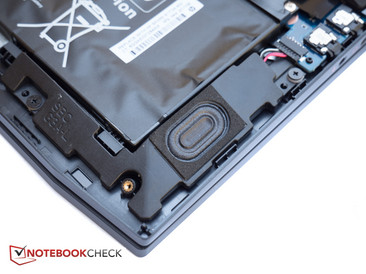
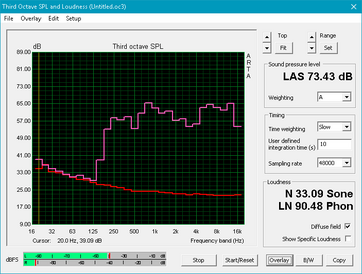
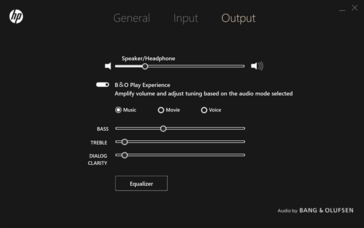
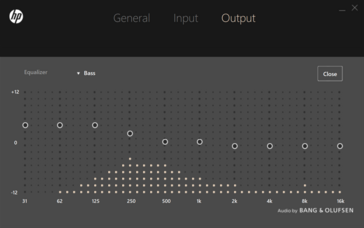
HP Omen 15t-ce000 audio analysis
(-) | not very loud speakers (65.4 dB)
Bass 100 - 315 Hz
(±) | reduced bass - on average 13.8% lower than median
(-) | bass is not linear (15.7% delta to prev. frequency)
Mids 400 - 2000 Hz
(+) | balanced mids - only 3.3% away from median
(±) | linearity of mids is average (10.4% delta to prev. frequency)
Highs 2 - 16 kHz
(+) | balanced highs - only 3.8% away from median
(±) | linearity of highs is average (7.2% delta to prev. frequency)
Overall 100 - 16.000 Hz
(±) | linearity of overall sound is average (21.7% difference to median)
Compared to same class
» 77% of all tested devices in this class were better, 5% similar, 17% worse
» The best had a delta of 6%, average was 18%, worst was 132%
Compared to all devices tested
» 61% of all tested devices were better, 7% similar, 32% worse
» The best had a delta of 4%, average was 24%, worst was 134%
Apple MacBook 12 (Early 2016) 1.1 GHz audio analysis
(+) | speakers can play relatively loud (83.6 dB)
Bass 100 - 315 Hz
(±) | reduced bass - on average 11.3% lower than median
(±) | linearity of bass is average (14.2% delta to prev. frequency)
Mids 400 - 2000 Hz
(+) | balanced mids - only 2.4% away from median
(+) | mids are linear (5.5% delta to prev. frequency)
Highs 2 - 16 kHz
(+) | balanced highs - only 2% away from median
(+) | highs are linear (4.5% delta to prev. frequency)
Overall 100 - 16.000 Hz
(+) | overall sound is linear (10.2% difference to median)
Compared to same class
» 7% of all tested devices in this class were better, 2% similar, 91% worse
» The best had a delta of 5%, average was 18%, worst was 53%
Compared to all devices tested
» 4% of all tested devices were better, 1% similar, 94% worse
» The best had a delta of 4%, average was 24%, worst was 134%
Frequency Comparison (Checkbox selectable!)
Graph 1: Pink Noise 100% Vol.; Graph 2: Audio off
Energy Management
Power Consumption
With an idle maximum of 22 W, our review notebook interestingly enoughs draws significantly less power than our previous Omen 15 with Full HD display, which required up to 30 W. Still, other Max-Q designs like the Dell Inspiron 15 7000 7577 gaming notebook with Nvidia Optimus technology need less than half as much (~9 W). Average load power consumption trails systems with the regular GTX 1060 slightly, but the difference isn't substantial. The heavy power adapter (over 900 g) is rated for 200 W and can easily handle the maximum power draw (established with Prime95 and Furmark running in parallel) of about 135 W.
| Off / Standby | |
| Idle | |
| Load |
|
Key:
min: | |
| HP Omen 15t-ce000 i7-7700HQ, GeForce GTX 1060 Max-Q, Samsung PM961 NVMe MZVLW128HEGR, IPS, 3840x2160, 15.6" | Lenovo Legion Y520-15IKBN 80WK0042GE i5-7300HQ, GeForce GTX 1050 Ti Mobile, Samsung PM961 NVMe MZVLW128HEGR, IPS, 1920x1080, 15.6" | Dell Inspiron 15 7000 7577 i5-7300HQ, GeForce GTX 1060 Max-Q, Samsung PM961 MZVLW256HEHP, IPS, 1920x1080, 15.6" | Gigabyte Aero 15 i7-7700HQ, GeForce GTX 1060 Mobile, Lite-On CX2-8B512-Q11, IPS, 1920x1080, 15.6" | Acer Aspire VN7-593G-73HP V15 Nitro BE i7-7700HQ, GeForce GTX 1060 Mobile, Seagate Mobile HDD 1TB ST1000LM035, AH-IPS, Normally Black, Transmissive, 1920x1080, 15.6" | HP Omen 15-ce002ng i7-7700HQ, GeForce GTX 1060 Max-Q, Samsung PM961 MZVLW256HEHP, IPS, 1920x1080, 15.6" | Aorus X5 v7 i7-7820HK, GeForce GTX 1070 Mobile, Toshiba NVMe THNSN5256GPU7, IPS, 3840x2160, 15.6" | |
|---|---|---|---|---|---|---|---|
| Power Consumption | 39% | 39% | 4% | 15% | -13% | -58% | |
| Idle Minimum * (Watt) | 15.4 | 5.2 66% | 7.1 54% | 12 22% | 7.2 53% | 18 -17% | 26 -69% |
| Idle Average * (Watt) | 22.4 | 8.3 63% | 7.6 66% | 15 33% | 10.5 53% | 23 -3% | 31 -38% |
| Idle Maximum * (Watt) | 22.4 | 10.1 55% | 8.6 62% | 20 11% | 16 29% | 30 -34% | 36 -61% |
| Load Average * (Watt) | 78.1 | 62.7 20% | 59.5 24% | 82 -5% | 82 -5% | 85 -9% | 93 -19% |
| Witcher 3 ultra * (Watt) | 97.5 | 94 4% | 89 9% | 111 -14% | 124 -27% | 96 2% | 176 -81% |
| Load Maximum * (Watt) | 133.52 | 100 25% | 112.8 16% | 161 -21% | 155 -16% | 158 -18% | 240 -80% |
* ... smaller is better
Battery Life
Given the lack of efficiency, we didn't have high expectations in regards to the runtimes of our G-Sync notebook. Despite the decently-large 70 Wh battery, the results are middling at best, with a real-world WLAN battery life at brightness of 150 nits of about 3 hours and 30 minutes. The Dell Inspiron gaming notebook has a smaller 56 Wh battery, but lasts twice as long, as it can make use of the processor-integrated GPU as well. Our other Omen 15 with Full HD performed very similarly, although its runtimes were slightly shorter. Gaming systems aren't know for their stamina, but considering the significant reduction of the performance on battery, we were hoping for a better result than what the Omen 15 delivers.
| HP Omen 15t-ce000 i7-7700HQ, GeForce GTX 1060 Max-Q, 70 Wh | Lenovo Legion Y520-15IKBN 80WK0042GE i5-7300HQ, GeForce GTX 1050 Ti Mobile, 45 Wh | Dell Inspiron 15 7000 7577 i5-7300HQ, GeForce GTX 1060 Max-Q, 56 Wh | Gigabyte Aero 15 i7-7700HQ, GeForce GTX 1060 Mobile, 94.24 Wh | Acer Aspire VN7-593G-73HP V15 Nitro BE i7-7700HQ, GeForce GTX 1060 Mobile, 69 Wh | HP Omen 15-ce002ng i7-7700HQ, GeForce GTX 1060 Max-Q, 70 Wh | Aorus X5 v7 i7-7820HK, GeForce GTX 1070 Mobile, 94 Wh | |
|---|---|---|---|---|---|---|---|
| Battery runtime | 54% | 77% | 83% | 70% | -9% | -20% | |
| Reader / Idle (h) | 5 | 10.6 112% | 11 120% | 10.6 112% | 8.4 68% | 4.3 -14% | 3.5 -30% |
| WiFi v1.3 (h) | 3.5 | 5.2 49% | 6.9 97% | 7 100% | 6 71% | 3.3 -6% | 2.5 -29% |
| Load (h) | 1.4 | 1.4 0% | 1.6 14% | 1.9 36% | 2.4 71% | 1.3 -7% | 1.4 0% |
Pros
Cons
Verdict
It's not overly difficult to find flaws when looking at lower-priced gaming laptops, as the manufacturer has to walk a careful line to balance comparatively inexpensive materials with good looks and potent-enough hardware to appeal to the highest possible number of users. For the Omen 15, we might be tempted to criticize the stamped upper metal shell with its rather sharp edges, the quite noticeable screen bleeding or the rather obtrusive fan system. But none of the shortcomings are a real deal breaker when it comes to a gaming system: all things considered, the HP Omen 15 is an affordably-priced Max-Q system with enough chops to handle many current games at least at Full HD display resolution.
The newer design with its more "in your face" styling might not appeal to all, but there's no question that the build quality itself is quite decent with good torsional rigidity of the base unit and little to no give on the keyboard deck. The input devices work well, the hardware packs a punch, and the bright UHD IPS display is - especially after a calibration - quite incredible for the price. The Omen 15 still gets fairly warm, but not nearly as hot as some other systems. The fans are, however, quite annoying, as they spin up frequently and often produce an oscillating sound which grates on the nerves.
Users shopping for an affordable low-to-midrange gaming notebook with 4K display should definitely put the Omen 15 on their list of potential candidates.
The Dell Inspiron 15 gaming notebook features an inferior display, but still very decent performance and lasts twice as long on a battery charge.
HP Omen 15t-ce000
- 12/01/2017 v6 (old)
Bernie Pechlaner




